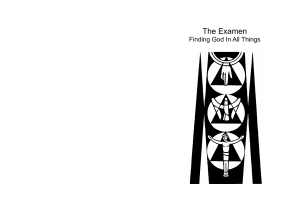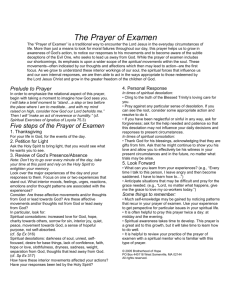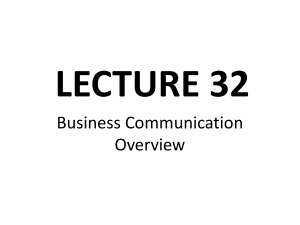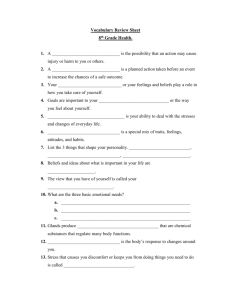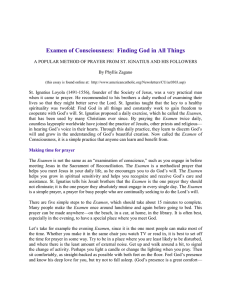The Ignatian Examen
advertisement
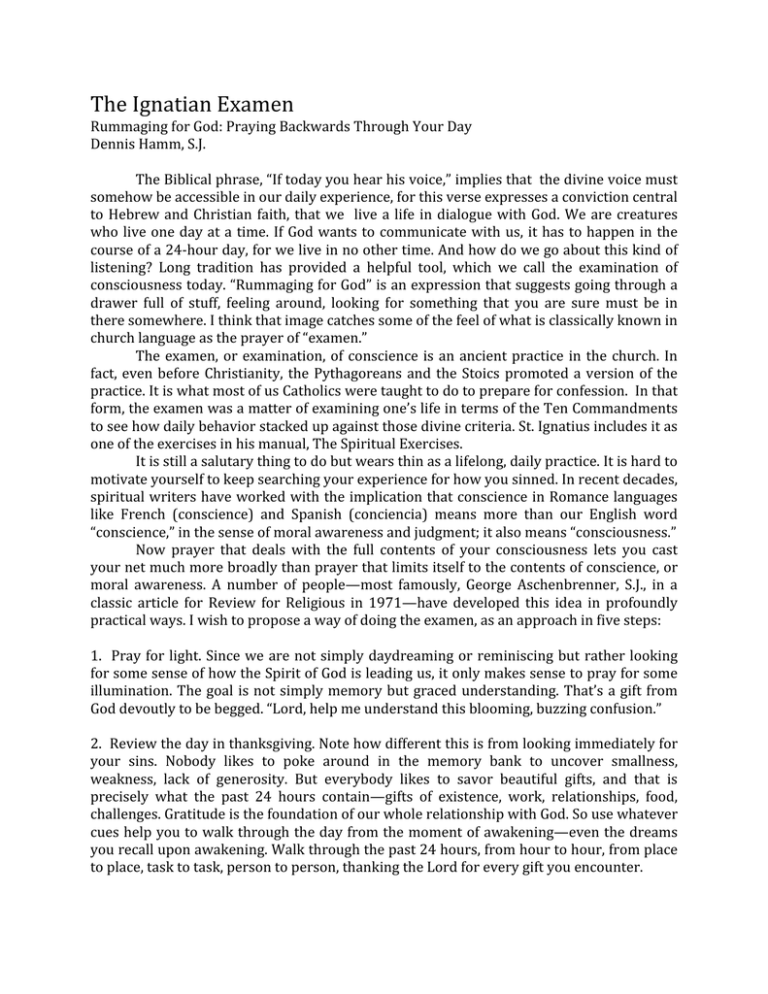
The Ignatian Examen Rummaging for God: Praying Backwards Through Your Day Dennis Hamm, S.J. The Biblical phrase, “If today you hear his voice,” implies that the divine voice must somehow be accessible in our daily experience, for this verse expresses a conviction central to Hebrew and Christian faith, that we live a life in dialogue with God. We are creatures who live one day at a time. If God wants to communicate with us, it has to happen in the course of a 24‐hour day, for we live in no other time. And how do we go about this kind of listening? Long tradition has provided a helpful tool, which we call the examination of consciousness today. “Rummaging for God” is an expression that suggests going through a drawer full of stuff, feeling around, looking for something that you are sure must be in there somewhere. I think that image catches some of the feel of what is classically known in church language as the prayer of “examen.” The examen, or examination, of conscience is an ancient practice in the church. In fact, even before Christianity, the Pythagoreans and the Stoics promoted a version of the practice. It is what most of us Catholics were taught to do to prepare for confession. In that form, the examen was a matter of examining one’s life in terms of the Ten Commandments to see how daily behavior stacked up against those divine criteria. St. Ignatius includes it as one of the exercises in his manual, The Spiritual Exercises. It is still a salutary thing to do but wears thin as a lifelong, daily practice. It is hard to motivate yourself to keep searching your experience for how you sinned. In recent decades, spiritual writers have worked with the implication that conscience in Romance languages like French (conscience) and Spanish (conciencia) means more than our English word “conscience,” in the sense of moral awareness and judgment; it also means “consciousness.” Now prayer that deals with the full contents of your consciousness lets you cast your net much more broadly than prayer that limits itself to the contents of conscience, or moral awareness. A number of people—most famously, George Aschenbrenner, S.J., in a classic article for Review for Religious in 1971—have developed this idea in profoundly practical ways. I wish to propose a way of doing the examen, as an approach in five steps: 1. Pray for light. Since we are not simply daydreaming or reminiscing but rather looking for some sense of how the Spirit of God is leading us, it only makes sense to pray for some illumination. The goal is not simply memory but graced understanding. That’s a gift from God devoutly to be begged. “Lord, help me understand this blooming, buzzing confusion.” 2. Review the day in thanksgiving. Note how different this is from looking immediately for your sins. Nobody likes to poke around in the memory bank to uncover smallness, weakness, lack of generosity. But everybody likes to savor beautiful gifts, and that is precisely what the past 24 hours contain—gifts of existence, work, relationships, food, challenges. Gratitude is the foundation of our whole relationship with God. So use whatever cues help you to walk through the day from the moment of awakening—even the dreams you recall upon awakening. Walk through the past 24 hours, from hour to hour, from place to place, task to task, person to person, thanking the Lord for every gift you encounter. 3. Review the feelings that surface in the replay of the day. Our feelings, positive and negative, the painful and the pleasing, are clear signals of where the action was during the day. Simply pay attention to any and all of those feelings as they surface, the whole range: delight, boredom, fear, anticipation, resentment, anger, peace, contentment, impatience, desire, hope, regret, shame, uncertainty, compassion, disgust, gratitude, pride, rage, doubt, confidence, admiration, shyness—whatever was there. Some of us may be hesitant to focus on feelings in this over psychologized age, but I believe that these feelings are the liveliest index to what is happening in our lives. This leads us to the fourth moment. 4. Choose one of those feelings (positive or negative) and pray from it. That is, choose the remembered feeling that most caught your attention. The feeling is a sign that something important was going on. Now simply express spontaneously the prayer that surfaces as you attend to the source of the feeling—praise, petition, contrition, cry for help or healing, whatever. 5. Look toward tomorrow. Using your appointment calendar if that helps, face your immediate future. What feelings surface as you look at the tasks, meetings, and appointments that face you? Fear? Delighted anticipation? Self‐doubt? Temptation to procrastinate? Zestful planning? Regret? Weakness? Whatever it is, turn it into prayer—for help, for healing, whatever comes spontaneously. To round off the examen, say the Lord’s Prayer. If we are to listen for the God who creates and sustains us, we need to take seriously and prayerfully the meeting between the creatures we are and all else that God holds lovingly in existence. That “interface” is the felt experience of our days. It deserves prayerful attention. It is a big part of how we know and respond to God. Dennis Hamm, S.J., a Scripture scholar, holds the Graff Chair in Catholic Theology at Creighton University, Omaha, NE. Reprinted with permission of America Press, Inc. 1994. All rights reserved. For subscription information, call 1­ 800­627­9533 or visit www.americamagazine.org.

